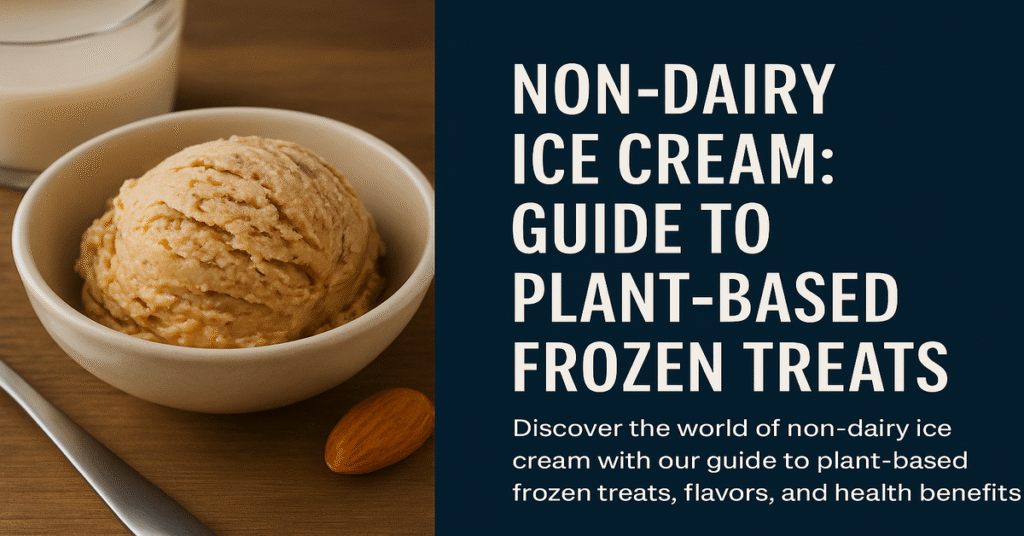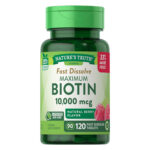In recent years, non-dairy ice cream has captured the hearts of dessert lovers worldwide. As more people explore dairy alternatives due to dietary restrictions, ethical concerns, or health preferences, the variety and quality of non-dairy frozen treats have skyrocketed. No longer a bland substitute, non-dairy ice cream now rivals traditional dairy ice cream in taste, texture, and innovation.
In this comprehensive guide, we’ll explore everything about non-dairy ice cream: its history, ingredients, production methods, nutritional aspects, and the vibrant future of this sweet category.
Understanding Non-Dairy Ice Cream
What Is Non-Dairy Ice Cream?
Non-dairy ice cream is a frozen dessert made without any animal milk. Instead of using cow’s milk, producers use plant-based alternatives such as almond milk, coconut milk, soy milk, oat milk, and cashew milk.
Why Choose Non-Dairy?
There are several reasons someone might opt for non-dairy ice cream’s:
- Lactose Intolerance: Many people cannot digest lactose, the sugar found in dairy products.
- Vegan Lifestyle: Vegans avoid all animal products, including dairy.
- Allergies: Some individuals are allergic to milk proteins like casein.
- Environmental Concerns: Producing plant-based milk generally uses fewer resources than dairy farming.
- Health Benefits: Non-dairy options may be lower in saturated fats and cholesterol.
A Brief History of Non-Dairy Ice Cream
Early Beginnings
The first known attempts to create dairy-free frozen desserts appeared in the early 20th century, mainly using soy milk in Asian communities where dairy consumption was already low.
Growth in Popularity
By the 1980s and 1990s, soy-based frozen desserts began appearing in health food stores. However, these early versions often lacked the creamy texture and rich flavor of traditional ice cream.
The Modern Revolution
With the explosion of plant-based foods in the 2010s, non-dairy ice cream experienced a renaissance. Brands began experimenting with a variety of bases like coconut, almond, oat, and cashew, achieving textures and flavors that rivaled or even surpassed traditional dairy ice cream.
Common Bases for Non-Dairy Ice Cream
Coconut Milk
Texture: Rich, creamy, high-fat content
Flavor: Subtle coconut flavor that pairs well with tropical or chocolate flavors
Coconut milk provides a luxurious mouthfeel and is a favorite among many vegan ice cream brands.
Almond Milk
Texture: Light, slightly watery compared to coconut
Flavor: Mild nutty undertone
Almond milk is popular for those seeking a lower-fat option, though it may require thickeners to achieve creaminess.
Soy Milk
Texture: Medium creaminess
Flavor: Neutral, slightly beany
One of the earliest plant bases, soy milk provides a good protein content and a relatively neutral taste.
Cashew Milk
Texture: Exceptionally creamy and smooth
Flavor: Mild, buttery
Cashew milk’s high-fat content and mild flavor make it ideal for replicating premium dairy ice cream.
Oat Milk
Texture: Smooth and slightly thick
Flavor: Sweet, slightly earthy
Oat milk has become incredibly popular for its sustainable production and naturally sweet flavor.
Key Ingredients in Non-Dairy Ice Cream
Plant-Based Milk
As discussed, the type of milk affects the flavor and texture dramatically.
Sweeteners
Common sweeteners include:
- Cane sugar
- Maple syrup
- Agave nectar
- Coconut sugar
Sugar not only sweetens the dessert but also impacts the texture by lowering the freezing point.
Stabilizers and Emulsifiers
To achieve the desired creamy texture and prevent ice crystals, stabilizers like guar gum, locust bean gum, and tapioca starch are used.
Flavorings and Add-ins
From vanilla beans to chocolate chips to swirls of caramel, the creativity in non-dairy ice cream is limitless.
Nutritional Considerations
Health Benefits
- Lower Saturated Fats: Especially if made with almond, soy, or oat bases.
- No Cholesterol: Plant-based products are naturally cholesterol-free.
- Rich in Fiber: Especially oat milk-based ice creams.
Things to Watch For
- Added Sugars: Some non-dairy ice cream’s can be high in sugar.
- Caloric Density: Coconut and cashew bases can be rich and high in calories.
- Additives: Always check labels for unnecessary chemical additives.
How Non-Dairy Ice Cream Is Made
1. Mixing the Base
Plant milk, sweeteners, and stabilizers are combined to create a smooth liquid mixture.
2. Pasteurization
The mixture is heated to destroy bacteria and blend the ingredients more thoroughly.
3. Homogenization
This process ensures the fats are evenly distributed, giving a smooth mouthfeel.
4. Aging
The base is cooled and aged for several hours to allow the flavors to meld and the texture to improve.
5. Freezing and Churning
The mixture is churned while freezing to incorporate air and prevent large ice crystals.
6. Packaging and Hardening
After churning, the ice cream is packaged and hardened to the final consistency.
Popular Non-Dairy Ice Cream Brands
Ben & Jerry’s Non-Dairy Line
Known for their indulgent flavors, Ben & Jerry’s offers almond milk-based options like Chocolate Fudge Brownie and Netflix & Chill’d.
So Delicious
One of the pioneers in non-dairy desserts, offering coconut, cashew, and oat milk options.
Oatly
Famous for its oat milk products, Oatly offers creamy, rich ice cream in popular flavors like Chocolate and Strawberry.
NadaMoo!
A coconut milk-based brand emphasizing organic and sustainable ingredients.
Haagen-Dazs Non-Dairy
A premium feel with flavors like Peanut Butter Chocolate Fudge using coconut cream as a base.
Making Non-Dairy Ice Cream at Home
Basic Recipe Template
Ingredients:
- 2 cups plant-based milk
- 1 cup full-fat coconut milk (for creaminess)
- 1/2 cup sweetener (maple syrup or sugar)
- 1 tbsp cornstarch or arrowroot powder
- 1 tsp vanilla extract
Instructions:
- Whisk plant-based milk, coconut milk, sweetener, and cornstarch.
- Heat until slightly thickened, stirring constantly.
- Cool mixture in the fridge.
- Churn in an ice cream maker.
- Freeze for 2-4 hours before serving.
Creative Variations
- Add cookie dough chunks
- Swirl in caramel or fudge
- Infuse with espresso or matcha
Challenges in Non-Dairy Ice Cream Production
Achieving Creaminess
Without animal fat, achieving a rich texture can be difficult. Cashews, coconut cream, and specific emulsifiers help bridge the gap.
Flavor Balance
Some plant milks have strong flavors (e.g., coconut, soy) that need to be balanced with complementary ingredients.
Preventing Ice Crystals
Plant-based ice creams are more prone to iciness; stabilizers and proper freezing techniques are crucial.
The Future of Non-Dairy Ice Cream
Innovations on the Horizon
Scientists are working on:
- Better emulsifiers derived from plants
- Precision fermentation for dairy-identical proteins without animals
- Cleaner labels with fewer additives
Sustainability Emphasis
Brands are increasingly focusing on eco-friendly packaging, carbon footprint reduction, and ethical sourcing of ingredients.
Expanding Global Markets
As plant-based diets grow worldwide, non-dairy ice cream will become more accessible in different cultural flavors like matcha, lychee, or saffron.
Conclusion
Non-dairy ice cream’s is no longer just a substitute for traditional ice cream — it is a vibrant, delicious category in its own right. With an impressive range of bases, flavors, and textures, today’s non-dairy ice cream’s can satisfy virtually every palate and dietary preference.
Whether you’re vegan, lactose-intolerant, eco-conscious, or simply an adventurous eater, non-dairy ice cream offers something for everyone. As innovation continues, the future promises even more exciting, sustainable, and indulgent frozen desserts.
Choosing non-dairy no longer means compromising. Instead, it invites a whole new world of flavors and experiences — one sweet, satisfying scoop at a time.
FAQs about Non-Dairy Ice Cream
Q1: Is non-dairy ice cream healthier than regular ice cream?
It can be, especially if it’s lower in saturated fat and added sugars, but always check the nutrition label.
Q2: Does non-dairy ice cream taste different from regular ice cream?
It depends on the base used. Some, like cashew or oat milk bases, taste very close to traditional dairy ice cream.
Q3: Can I make non-dairy ice cream without an ice cream maker?
Yes! You can use the “no-churn” method by freezing the base and stirring it every 30 minutes until creamy.
Q4: What is the creamiest non-dairy ice cream base?
Cashew milk and full-fat coconut milk are generally considered the creamiest bases.
Q5: Is non-dairy ice cream suitable for people with nut allergies?
Some options are nut-free (like oat milk-based ice creams), but always check labels for allergens.
Q6: How long does non-dairy ice cream last in the freezer?
Properly stored, non-dairy ice cream typically lasts 1–2 months, although freshness and texture are best within the first few weeks.







